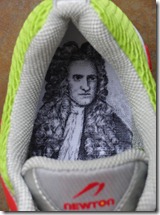 Let me state openly at the outset of this review that my first experience with a pair of Newton running shoes was not a good one. In winter 2009 I received a pair of Newton Sir Isaac’s – I think this was the first pair of review shoes that I’d ever received – and I was quite excited since I had heard a lot abut Newton and thought the concept looked interesting. Turns out that despite the fact that I had been running in Nike Free 3.0’s and Vibram Fivefingers for 6-9 months at the time, I had a really hard time staying off my heels in the Sir Isaac’s. The shoes never really clicked with me, and I said as much when I wrote my Sir Isaac review.
Let me state openly at the outset of this review that my first experience with a pair of Newton running shoes was not a good one. In winter 2009 I received a pair of Newton Sir Isaac’s – I think this was the first pair of review shoes that I’d ever received – and I was quite excited since I had heard a lot abut Newton and thought the concept looked interesting. Turns out that despite the fact that I had been running in Nike Free 3.0’s and Vibram Fivefingers for 6-9 months at the time, I had a really hard time staying off my heels in the Sir Isaac’s. The shoes never really clicked with me, and I said as much when I wrote my Sir Isaac review.
Late last summer my friend Mark Cucuzzella, owner of the Two Rivers Treads Natural Running Store, convinced me to give Newton another chance and offered to send me a pair of Newton Distance Racers to try out. I agreed to give them a try, and I’m honestly quite happy that I did.
The Distance Racer is Newton’s lowest profile shoe, with a heel-forefoot drop of only 2mm. Despite this low ramp angle, Newton’s are far from what I would call a true minimalist shoe – and to their credit, they don’t claim to be minimalist. There is a healthy slab of firm midsole in the Distance Racer, and the measurements reported by Running Warehouse bear this out – 30mm heel, 28mm forefoot. Furthermore, the Distance Racers sport Newton’s trademark forefoot lugs, which compress and spring back with each step (see sole image below). In other words, there is quite a lot of material and technology underfoot. Despite this, weight is still kept reasonable, and my Distance Racers come in right at 8.6 oz in size 10.
What I have found from running in the Distance Racers is that the low heel-forefoot drop combined with the unusual feeling created by the protruding forefoot lugs makes these shoes an excellent choice for someone looking for a more substantial shoe that will still encourage a barefoot-style gait. I have found it quite easy to maintain my form in these shoes – a far better experience overall than I had with the Sir Isaacs. If you’ve never experienced the feel of Newton shoes, it really is a lot different than other running shoes. The forefoot lugs are immediately noticeable when you put them on, to the point where I don’t really enjoy walking in them. Any heel to toe rolling over the lugs makes you feel like you are hitting a speed bump, and this helps to encourage a midfoot or forefoot strike.
There is really quite a lot that I like about the Distance Racers. The upper is roomy and well constructed, and fit and feel are both excellent. In particular, the toebox is high-volume, making for a very roomy forefoot fit. I also like the wide open mesh used in the upper as it allows for fantastic ventilation. There is very little arch support, and the removable insoles are completely flat. I have run in these shoes both with and without the insoles, and the latter is a perfectly viable option and makes for an even roomier fit (as well as a firmer ride). From an aesthetic standpoint, this shoe hits my sweet spot – the neon yellow and red simply look great.
From a performance standpoint, I have been pleasantly surprised by the Distance Racers. In fact, lately I find myself grabbing them frequently, and I’ve recently turned in some amazing runs in these shoes (including a sub-34 5-miler and a sub-19:00 5K – both were solo time-trials and these times are near my best for each distance). I can’t say that the lugs actually provide any kind of meaningful propulsion, but there is something pleasant about the way they compress as your center of mass passes over the shoe.
If I have one gripe about the Distance Racers, and Newton shoes in general, it’s that making sharp turns in the shoes can be a bit sloppy. Because the lugs do not extend all the way to the sides of the sole (see photo above), cornering can cause you to feel a bit unstable on the forefoot – kind of a side-to-side rocking. Word is that Newton has developed the ability to make the lugs go all the way across the forefoot to the edges on each side, and this will appear first in their 5.8 oz MV2 Speed Racer flat set to be released in the not too distant future (you can see the Newton MV2 Speed Racer here in the June issue of SGB Performance).
It’s also worth mentioning the other drawback of Newton shoes: price. Like all other Newton shoes currently on the market, the Distance Racers are an investment at $155. I have heard many people say that they get a lot more miles out of a pair of Newton’s than they do out of other shoes, so the cost may be justified. I will also say that I think highly enough of this shoe that I bought a pair for my wife to rotate along with her Vibram Bikilas – getting her to work on her form seems to have mostly resolved a chronic hip issue that she had been dealing with up until last Fall (her experience is one of the reasons why I’m such a believer in this stuff!).
All in all, I have been impressed with the Distance Racers, and suspect that they will retain a regular spot in my shoe rotation. Even moreso, I have been impressed by Newton as a company. I have had the opportunity to speak with Ian Adamson, Newton’s director of product development, on several occasions, and met him in person at a running injury conference in Shepherdstown, WV back in January. What comes across clearly in talking to Ian is that Newton genuinely believes in their product and the virtues of natural running, and they are strong advocates of getting directly involved in running communities through educational outreach and training workshops. I’m apparently not the only one who thinks that Newton has a unique and positive approach, as just this past week news came out that former Reebok CEO Paul Fireman has invested 20 million dollars in Newton Running Company – big things appear to be ahead for Sir Isaac!
The Newton Distance Racer can be purchased at Running Warehouse.
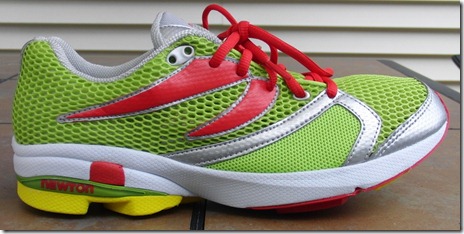
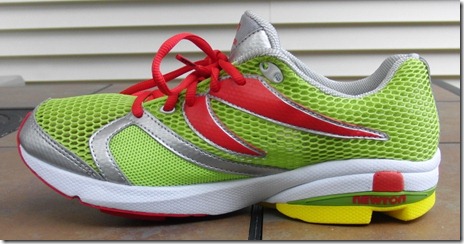

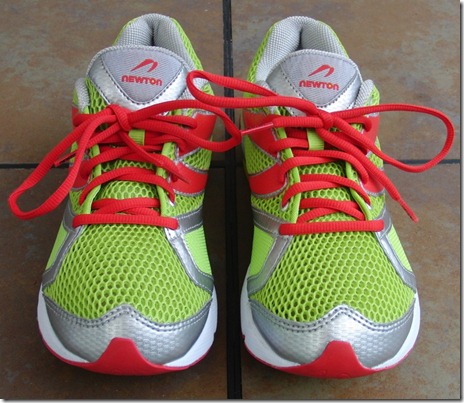
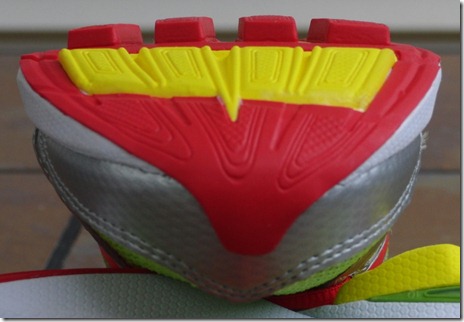

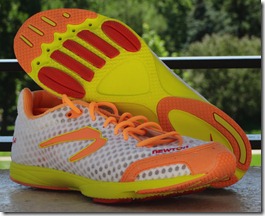
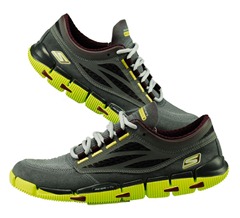















I still love my Sir Isaacs. They were my first shoe and although I do short runs in Scotts, the Isaacs are the only ones that don’t give me crushing pain in my forefoot after mile 4. They have 800+ miles on them and saw me through 12 half marathons in my first year of running (8 were in 56 days), so I think the shoes are working for me. And, I love that they make sure the distributors are well trained.
Pete, glad you like the shoes and thanks for the nice post. you will also love the new MV2 out later this year. i’ve been running in a prototype. Lower to the ground for someone like yourself who is several years into form change and minimal shoes.
In our store the Isaac has been an excellent and safe transitioning shoe for many new and experienced runners. It is durable and allows the feel and protection of a shoe as runners start to learn and understand better form at their own pace.
Distance a great fit for someone who is already efficient like yourself . The midsole is NOT traditional EVA foam and does stand up easily to 1000 plus miles if your form is good. Bad form will trash this and any shoe. The shoe should teach you….and supplementary barefoot running teaches best.
Best,
Mark Cucuzzella
Mark or Pete, any thoughts comparing this to the Altra Instinct as a marathon race shoe? Doing all of my runs in minimalist shoes (Brooks GS and VFF Bikilas), but looking for a marathon shoe for the fall.
Marks the guy to ask for this one – he’s run many marathons in the Newtons.
I have not.
Mark or Pete, any thoughts comparing this to the Altra Instinct as a marathon race shoe? Doing all of my runs in minimalist shoes (Brooks GS and VFF Bikilas), but looking for a marathon shoe for the fall.
I am not Mark or Pete but I may be able to help a bit. I have tried on the walked around in the Altra Instincts and ran some marathons in the Newton Distances. The Altra is a zero drop shoe but has plenty of cushion. I would have no issues running a marathon in these shoes assuming I had no fit issues. I am already a midfoot striker and run in Merrell Glove and VFF fairly often. When I did run in the Newton Distances I was not quite as efficient as I am now at a midfoot running style and still felt there was plenty of cushion for the long distance. They are a 2 mm drop so it would be tough to distinguish this difference between the Altra and these. The Newtons definitely feel different underfoot from any other shoes I have tried. I did a review of them on my site a while back if you are interested: link to ymmvreviews.com…. Since I was not quite as efficient, I noticed my form would break down towards the end of my long runs and the shoes did not last too long for me. As Mark has said, bad form tears these up, good form will last for a long time. I would love to try the new ones coming out as I think my experience would be much better now. I hope this helps.
JJ
YMMV Reviews
link to ymmvreviews.com
I agree with most of what you say, I’ve had mine for 15 months now and run 2 London Marathons, two 20 mile races and 2 half marathons in them plus many long progression and tempo miles in them.
I’ve set quite a few P.B.s in them along the way a 1.17 half marathon and 2.47 at London.
I think the NEW Newton Racer MV2 should address most of the things I don’t like about the distance race ie; lack of flexibility in the forefoot, overweight [for short races] and the fact its not a true zero drop [ I cut the heels down mine and the shoes feel much better!
So looking foreward to the MV2 I’ll buy a pair for sure!
Hi Pete. Slightly off-topic but I wonder if your wife has written/might write something about resolving her hip issue? I’m also working through chronic hip problems and switching to minimalist shoes and working on form have been a big part for me too, so it would be interesting to hear her experience.
I’d also like to hear how your wife is coming along, hope all is well. It’d be interesting to see video on her as a comparison to before.
Pete, have you had a look at the 2nd version of the Minimus yet? My local running shoe store just got them in stock – 0 deg lift, apparently, compared to the 4 deg in the first version. I probably won’t get a chance to test them until later this year, as I’ve racing comps coming from NB for testing for July.
Kent,
She’s doing very well – pretty much back to her 2-3 times per week running
schedule plus 2 yoga sessions per week. She gets a bit of ache from time to
time, but it seems to be in a different location than before. I have video,
and will try to get a post up about it all at some point.
Pete
Oh, and are those the MT20? They are releasing that first as a sequel to the
MT10 and I think it is still 4mm drop with a modified upper. Hopefully they
fix the forefoot fit issue. As far as I have heard, the zero-drop version is
not out for awhile yet.
Pete
Mark,
I’m going to try and have her write something on her experience, but not
sure when. The big plus is that she is now running 2-3 times per week with
minimal pain, whereas last Fall she was pretty much resigned to not being
able to run. I migrated her into Vibrams over the winter on the treadmill
very slowly, and now she is running outside in a mix of Newton’s and Merrell
Barefoot Pace Gloves. Keeping fingers crossed that things will continue in a
positive way!
Pete
Long ago now, and still off-topic, but stumbled across this again and thought I would post an update on my own hip problem – happy to report this is now 100% fixed thanks to some work with a wonderful sports therapist. In my case the answer was ridiculously simple: stretch those hamstrings properly! I’d been cautious with my hamstring stretching since I had a disc injury and was always nervous about irritating it. Now after 2 years of hip pain and just a few weeks of traditional “touch your toes” hamstring stretching, taking care to keep a straight back and not worry too much about actually reaching the toes (I am 6’4 and about as flexible as a plank of wood), my hip pain is gone completely. Now struggling a bit with some kind of Morton-neuroma-like foot pain, but that is another story :)
Thanks Mark – my wife is also working with a good therapist and found that she has a restriction in her hip flexors on one side, things are improving. I’m still curious as to why running in Vibrams on a treadmill never seemed to cause her trouble. Glad to hear that you issues have resolved!
Sent from my iPad
Hi Pete… I loved my Newton Racers… However, I had two problems. One, I would often roll my ankles on longer runs. I am assuming this is because of how high off the ground they are. And two, they wore down on the outer-upper soles way too fast. After about 280 miles my feet were noticeably on a incline when wearing them. This could be how I run and strike the ground? But at 155 dollars a pop! I couldn’t justify buying another pair and went to the Kinvaras.
The rolling I think is also related to the lugs not extending to the edges,
and is something I notice as well. Haven’t had much wear on the soles
though.
Have you tried the Newtons on any trails? Almost every shoe I own sees some trail running–even the skimpiest racing flats like the Mizuno Wave Universe is OK for some trail running. I’m worried the Newtons are too high off the ground and lack stability.
-Chris
Don’t think that I’ve taken them on any trails. I agree, prefer to be closer
to the ground on trail runs.
I tried a pair on while checking out shoes to help with my shin issues and they were definitely weird when walking, granted don’t think the Distance racer model was the one I tried. i felt good running on paved, but wonder how that trail experience would be as well. In the however…the price is a little too steep for me :(
I’m glad you gave a different pair of Newton’s another try, as I too have found wearing them while running to have contributed to improvements in my mid-foot running form while simultaneously allowing me to set several P.R.s. (I use their distance stability trainer). Consistent with what you’ve heard elsewhere I’ve found that I typically get 20-40% more miles from my Newtons (I’m now on my 3rd pair) than my other periodically worn shoes (Nike Free Run, Saucony Kinvara, Brooks Adrenaline).
I enjoy your reviews Pete. Now that you’ve reviewed both shoes, what do you see as the differences between the Sir Isaac and the Distance Racers? I’m looking to make the switch to a Newton shoe, so I’m curious as to what your thoughts would be in comparing the two.
To me the Sir Isaac was way too much shoe. Heavier, bigger heel lift,
etc. Felt kind of clunky. I like the Distance Racer a lot more.
Sir Issac Newton will be rolling in his grave with the misuse of his good name by Newton Co.. If he were alive today they simply wouldn’t be able to play this marketting stunt.
I’m sure he’d point out all the flaws in there theory as well, go have a look at the page:
link to newtonrunning.com…“The forefoot strike happens naturally right below your center of gravity”Errhhh… No it doesn’t. Anyone who actually understands Newtonian mechanics will know that their statement about forefoot strike is wrong. It doesn’t give me too much confidence in there ability to get the rest of the shoe right as well. The positioning of the lugs is dreadful for applying lateral forces, combined with such a high amount of cushioning will result in an unstable footplant when cornering or traversing. This is just bad design.The thickness of the sole and elevation of the front of the shoe from the group will also mean that the toes won’t load or flex naturally. I can see how this might be useful if you have problems with toe joint flexibility but for 99% of runners you’ll be robbing them on normal foot mechanics.I’m pretty sure that Sir Issac Newton wouldn’t be impressed. Worst still thanks to the marketting on the insole you rub his face in it every time you plant you foot. Pretty disrepectual to one of the greatest humans every to have lived.
And yes… as an engineer I’m effectively a desciple of Newtonian mechanics, Sir Isaac Newton is a personal hero, so I’m a little more senstive to misuse of his good name, but boy why did it have to happen with a company that can’t even get Newtonian mechanics right.
Lighten up Robert. I just started running in the Sir Issac and think it’s a great running shoe. It allows me to land naturally and still gives protection from the ground, something most minimal or natural running shoes sorely lack. I’ve burned through two pair of Kinvaras, which I loved, but the Newton really has the natural running mechanics and foot protection just right.
So I can only assume you think it’s perfectly OK for a company to leverage the credibility of a historical figure and then peddle their psudeo science to sell their shoes. Is it OK to decieve the public?I don’t think it is, holding a company to account is something we should all do, otherwise they will keep up the deceit. What I’d encourage them is to ditch the pseudo science, they might just learn something about how to make a better shoe in the process.As for the shoes providing natural running mechanics – they don’t. We aren’t born with 30mm of cushioning on our feet, we don’t need 30mm of cushioning to protect ourselves, even if you heel strike. The Netwon’s might not discourage a forefoot strike but only of the store with natural running mechincs.A huge factor in natural running mechanics is proprioception, the more cushioning and artificial support a shoe has, the lower proprioception is. If you decrease proprioception then you increase the risk of injury, and very likely to reduce efficiency along with it. The present Newton shoes will all score very poorly in proprioception.One way of testing one aspect of proprioception is to balance on one leg with a flat foot – try it with shoes and barefoot. Then try the same test rising up onto the balls of your feet. Try this with different shoes.Another big factor in ankle injuries in particular is the rolling moment that your ankle has to sustain when your are cornering, contouring or when you’ve rolled your foot over – such as when you catch a curb or a stone, or rut awkwardly. To test this out stand on one leg and deliberately roll your ankle over to 45 degrees. Do the test with a number of different shoes and barefoot.With the ankle rolling test the best will be barefoot, then the height of the ankle above ground and the shape of the sole will factor for how well a shoe will cope with this stress test – shoes with lots of cushioning in the heel or foot will perform poorly.So in two very important aspects the Newton shoes will perform poorly, others commentators below have said that ankle rolling is a problem so it’s not just an idle theory. These are design flaws that cause injuries, rather than protecting your feet they are increasing risks – who’s going to protect you from your shoes?As an aside, the Kinvara’s has lots flaws too – toe box is too small, too much arch support, and the sole has rather poor durability, almost to the point of wondering whether it’s designed to wear out really quickly. We should run around being apologists for running shoe manufactures. If their kit has flaws we need to talk about it.
Robert,
I agree with many of your points, but shoes all come with compromises.
Newtons work well for some people, and some people will never go with no
cushion or zero drop, and these are a lot better than many of the heavily
cushioned options that are out there. That being said, if someone created a
shoe called the Darwin and claimed to have improved on the human body, it
would irritate me as an evolutionary biologist to no end!
PEte
Hi Pete,
“I agree with many of your points, but shoes all come with compromises. “
30mm of cushioning hardly much of compromise. The present Newton’s really are more closer related to the Mizuno’s Wave Prophecy than they are to the likes of five fingers or trail glove. They are all maximilist shoes with a low heel drop and low arch support.
Sure the Newtons might work for some people, but so will the Prophecy. Both sets of people might also be better served by other shoes.
“That being said, if someone created a shoe called the Darwin and claimed to have improved on the human body, it would irritate me as an evolutionary biologist to no end!”
I think it would be closer analogy to say a shoe caled the Darwin that claim to improved on the human body and then used marketing with Darwin all over them and psuedo science on their promotional litrature that owed more to “Intelligent Design” than the theory of Evolution.
Of course the engineer in me would say that we can improve on evolution in the footwear department… it’s called inline skates, the world record for the marathon is sub 1 hour, yeehaw!!
Won’t help you run down a Kudo though ;-)
From a build and amount of material standpoint, you’re probably right about
the Newtons being closer to the Prophecy. But, in terms of the type of
kinematics that the two shoes encourage, I’d bet the Newton’s are more
similar to the Vibrams. Very few shoes compare to the latter in terms of
proprioreception if you ask me though. In the end, if a shoe like the
Prophecy let’s someone run injury free, so be it. Running is what it’s all
about after all!
Pete
Yeah, and I hate the way Nike has stolen the good name of Athena Nike. From the Parthenon to the bottom of half the feet it America. Woe! Woe!
I switched to Newtons this spring. I worked up my mileage in them slowly as I was transitioning to a forefoot strike. I really loved the Newtons on many levels. They really encouraged the forefoot strike, the quality and fit is also top notch. I got up to a little over 7 miles in them, no issues. Then about two weeks ago during a 5k (in my Newtons) my left heel started to hurt. For a couple days following the race I was. In pain just walking. Achilles tendinitis. Rested for a week, iced, etc, then did a test run in my Kinvaras- just 1.5 miles- but felt pretty good. A few days later headed out for a four miler in my Newtons and 15 minutes into severe pain again. I think I am done with the Newtons. Their design does put a lot of load on the achilles tendon, and for me it appears to be too much. Back to the drawing board for shoes/running style for me.
They can be tough on the Achilles, and my guess is that racing in them may have been your trigger. Speed tends to amplify things.
I’ve had problems with my Achilles tendon too when transitioning into zero drop shoes. This is quite common, the aching calves every newbie minimalist is talking about can become Achilles tendon problems. Problem is that it takes long time to retrain and reshape the tendon to restore its function so it can handle zero drop, so one needs to be patient. It can be more than 6 months when the calves is clearly limiting how much one can run.
I did lots of eccentric strengthening (still do) and also stretching since my tendons was a bit short.
Thanks for the great review. Because you said these shoes would be good for someone looking for a stable barefoot gait would you suggest these for people with no arch? I have such a hard time finding shoes that give me enough support I have not got into the barefoot yet…
thanks!
Liz-CoolProducts
I’m not a big believer in arch support, and these have very little. If you
feel you need it, these probably are not the best choice.
Pete,
Thanks for the reviews. I just ordered a pair of Newton Distance Racers and entered your promo code. I have always wanted to try Newton, so here goes! Thanks again!
I can do it…